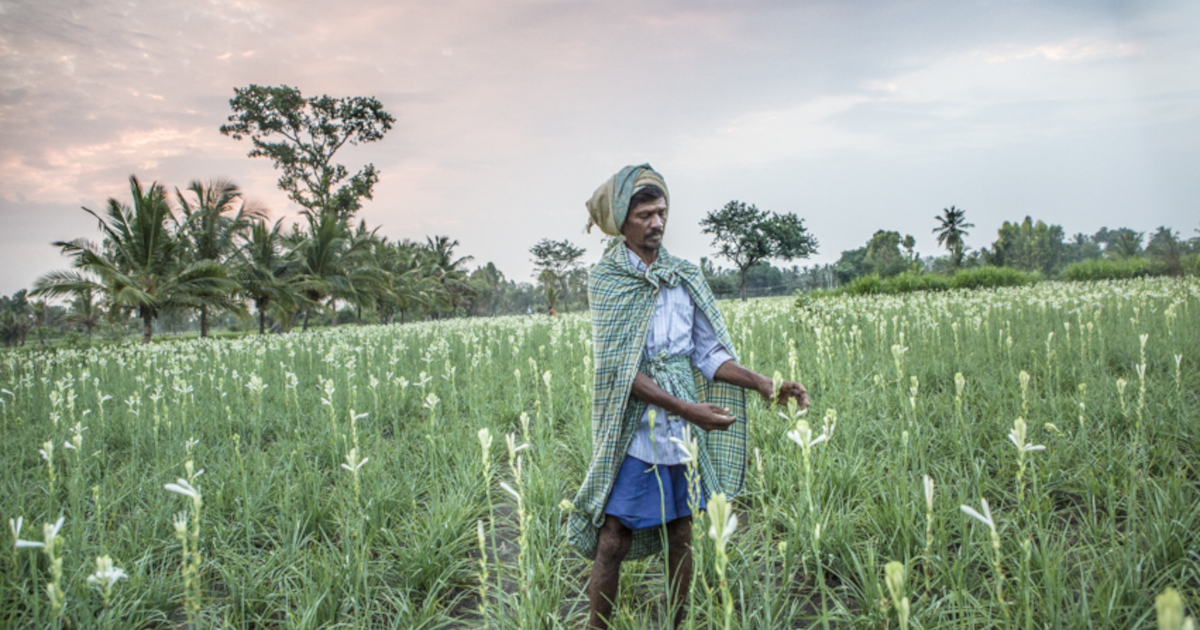Cette publication est également disponible en :
Français
On the occasion of the International Exhibition of Raw Materials for Perfumery (SIMPPAR) which will take place on May 31 and June 1 in Paris, we invite you to discover a series of articles originally published in the book From Plant to Essence. A World Tour of Fragrant Raw Materials. For the last leg of our journey, let’s embark for India, where LMR Naturals, IFF’s subsidiary for natural ingredients, has partnered with Nesso, a tuberose producer.
Once cultivated in southern India primarily for ornamental purposes, tuberose is now the focus of a sector specifically reserved for perfumery, at the behest of LMR Naturals, IFF’s natural ingredients subsidiary. Tuberose is ubiquitous in India, where it is grown in Tamil Nadu and Karnataka, and can be found adorning women’s hair, decorating temples during ceremonies and weddings, or braided into necklaces and garlands. Only about 10% of its flowers are destined for the perfume industry, which has an enduring love affair with this voluptuous scent, known in Hindi as rajnigandha.
LMR has entered into a partnership with the supplier Nesso, the country’s main producer of the flower. As a raw materials extraction specialist, it runs three factories close to the cultivation areas, near the cities of Madurai, Sathyamangalam and Mysore. Here, the “bulbs” (actually rhizomes) are planted from February to March. To ensure it flowers in July (and as early as March in the second and third years), the tuberose requires water, fertilizer and, above all, careful manual weeding of the plots. Harvesting takes place from March to December and is traditionally carried out in the early morning: The still-closed, often pinkish buds are delicately removed from the flowering stem. They are first taken to a collection point in the nearest village and are then sent out to several flower markets throughout the day. There, tuberose is sold as an ornamental flower. Prices vary according to supply and demand, often commanding up to as much as 10 euros per kilo at the height of the wedding season. “This is a prohibitive price for the perfume industry, when you consider that you need 7 metric tons of flowers for 1 kilo of absolute,” says Sophie Palatan, R&D Crop Science Development Manager at LMR. Tuberoses destined for extraction are therefore bought at the end of the day, when its price is at its lowest, and only during the peak production periods of April to June and September to December. Since 2020, however, LMR and its local partner have set up their own perfumery production chain, which allows them to operate outside of traditional supply channels. Last year, Nesso obtained over half of its tuberose directly from its producer network. Working in this manner provides better quality control and product traceability, as well as the establishment of good agricultural practices, such as reduced pesticide use, improved irrigation and fertilization techniques, research into mechanized weeding, etc.
Cutting out the intermediaries and purchasing directly from farmers also means shorter lead times between picking and processing, ultimately resulting in fresher flowers. “By committing to a given quantity and price in advance, the company also enables farmers to engage in tangible forward planning and to receive a fair income,” says Palatan. These efforts to create a reasonable and responsible culture have won them Ecocert’s For Life certification, a first for tuberose. Finally, setting up land dedicated specifically to perfumery production has permitted LMR to add to its range a new exclusive quality of absolute – Tuberose Blooming – whose scent is even closer to that of the fresh flower itself.
This article was originally published in the book From Plant to Essence. A World Tour of Fragrant Raw Materials, by Nez.
You can read all about this flower in the book Tuberose in perfumery, in the collection « Nez+LMR naturals notebooks », available on the shop.
Main visual: © Grégoire Mähler








Comments